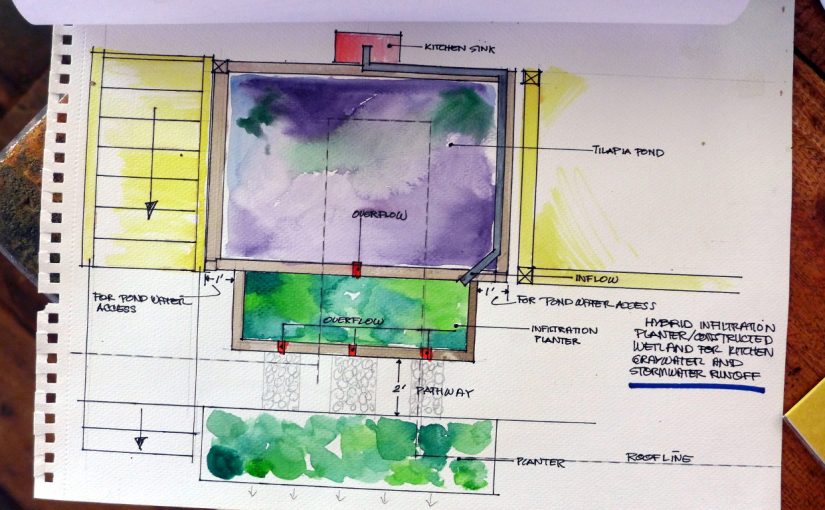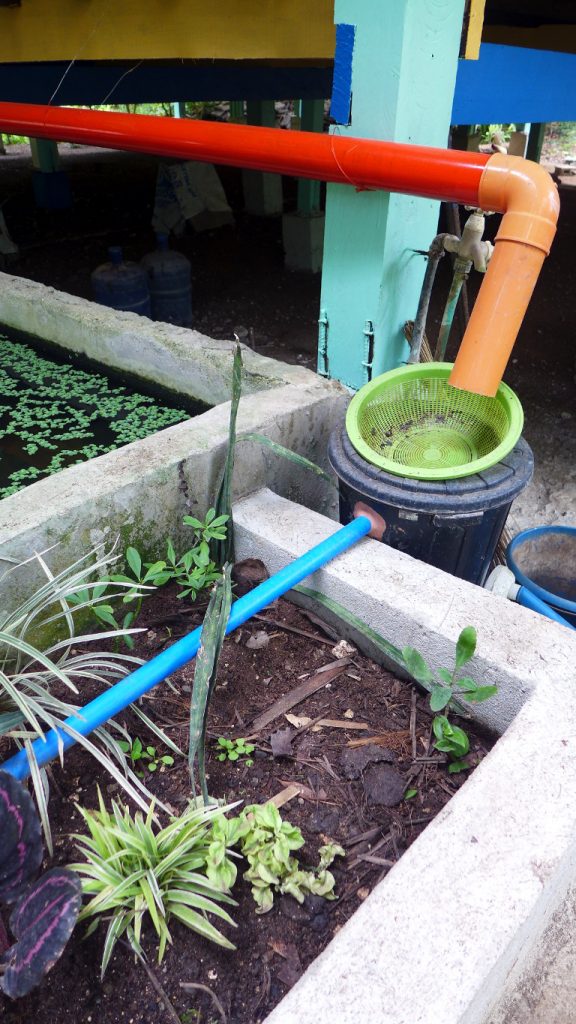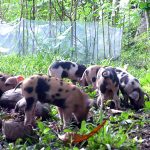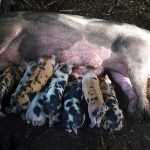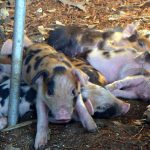We started with a pair of adult ducks – male and female. We kept them in a bamboo fenced area of about 20 square meters. We clipped their wings so they wouldn’t fly over the fence. We provided a large basin of water for them to swim in. We built a small scrap wood shelter for them too. We fed them chicken pellets, pig pellets, kitchen scraps. Our free range native chickens sometimes ate with the two ducks and we had no troubles with that. We even kept a piglet in that area for a while.
After a few weeks, the hen started laying eggs under the bamboo grove. We got excited! To protect the nest, we placed a roof made of wood and tarp over it. By then the ducks have become accustomed to their new home so we removed the bamboo fence. They roamed freely in an open area of about 1,500 square meters. But they always stayed near where we fed them. After 35 days, 12 ducklings hatched and all grew up to become our first flock of ducks. There were no fatalities.
Should you decide to raise ducks in your backyard, here are some tips to help you get started. These ideas may be suitable for backyard settings with an area of about 25 to 1000 square meters, a natural environment, not concrete, for a flock of 2 to 25 ducks.

Before Getting Your Ducks…
Plan ahead. Consider the following.
Protect Your Plants
Little ducklings won’t be a problem. But as they get older, from 4 weeks on-wards, they will start feasting on your plants. A group of 6-8 week old ducklings can kill a banana plant, demolish a gabi patch and dig up camote, ubi, singkamas tubers. If you have a leafy vegetable patch, the ducks will eat the veggies. They will kill squash fruits and flowers. So you will need to protect your plants if you want to let your ducks roam freely in your garden.

Fence your plants with bamboo, scrap wood, chicken wire or netting. The fencing doesn’t need to be very high. A foot high will do. Raised vegetable plots also discourage ducks from attacking. To prevent ducks from attacking the soft trunk of banana and stems of gabi plants, you may also grow thick and sturdy ornamentals around the base of these plants. Twigs, branches, and mulch from grass and dry leaves may also discourage ducks from entering a no-go zone.

Alternatively, you can fence your ducks in a part of your backyard, away from the most precious plants in your garden. A fence about a foot high should be sufficient. If ducks fly over, trim their wings. Be sure that ducks have enough space to wander around. Unless you have lots of ducks in a small space, they aren’t really motivated or determined enough to destroy most ornamentals. Ducks can’t reach the fruits of shrubs and fruit trees. Grass should be okay, but in a small space with a lot of ducks, grass can be killed by ducks trampling and by the build up of effluent.

Protect Your Ducks
When you bring home your ducks, they will want to escape and go back to where they came from. You’ll need to get them accustomed to their new home. You can do this by caging or fencing them in your preferred location for the first 2-4 weeks. Ducks will stay where they are fed, watered and treated well.
At the same time, caging or fencing will protect your vulnerable ducklings from predators such as cats, dogs, large lizards, snakes and birds of prey.
Food and Water
Give your ducks and ducklings water as soon as they arrive. After an hour or so, you can start giving them food. For ducklings, chick booster pellets, crumble or piglet starter is fine. Don’t give pollard, hog mash or rice hull. It will clog up their crops and kill them. If you notice something is wrong with their crops, give them a bowl of sand and water. The sand may help them unclog their crops.
Adult ducks can eat commercial duck feed. If duck feed isn’t available, chicken or pig pellets is fine. Kitchen scraps, grated coconuts, hog mash, pollard, azolla, duckweed, banana trunks, de-boned fish trimmings, etc. are all fine. Ducks also eat mosquitoes and other insects. Give the ducks a varied diet, not just commercial feeds. If you have lots of surplus food, you won’t need commercial feeds at all.
Basically, ducklings and young ducks will need 18-25% or more protein in their diet, while adult ducks can do fine with 12-14% protein.
Feed adult ducks twice a day – early morning and late afternoon. Ducklings can be fed three times a day. However, ducks will look for food almost all day.
So, to keep your ducks away from your plants, you can give them something to forage on. Look at what you have in surplus. Papaya? Bananas? Coconuts? Just cut them open and leave on the ground for the ducks to find. We love coconuts – we cut them open and leave on the ground and the ducks will spend many happy hours on those. The coconuts will also attract flies and other insects which the ducks will love to eat.
Rest and Recreation
It is imperative that you provide water for bathing. Ducks need to clean themselves and swim. In a small backyard, a basin of water will do. A plastic container cut in half also works fine. Have several of these if you have lots of ducks. Larger yards can have a pond built especially for ducks. Design ponds that have drainage or overflow and are easy to clean. Duck ponds can be 6 inches to 3 feet deep or preferably sloping, and should be about 1 square meter area per duck.
In this video (below), we use the shallow plastic lid of a bucket as swimming basin for ducklings. There are 8 newly hatched ducklings with their mother. Don’t use a deep basin in such a case. If you do, the mother will attempt to swim in the basin and she will crush and drown her ducklings. If you want the mother to swim with her ducklings you must build a pool that is large enough for all of them.
In this video (below), a duck bathes in a tray of water. This shallow basin poses less danger than a basin that is deep. Ducklings can get trapped and drown in a deep basin.
Nesting
Ducks will mate and start laying eggs at around 6-8 months of age. They will look for nesting places in their environment. In our experience, ducks will lay their eggs on the ground away from view. They will not lay eggs in elevated nesting boxes lined with cloths, sacks, dry grass etc. like chickens do.
In these photos (below), we use scrap wood as nesting houses for ducks. Our ducks love these. We have nesting houses under the house, under the dirty kitchen and under a bamboo grove. Put nesting houses in locations that don’t get flooded.

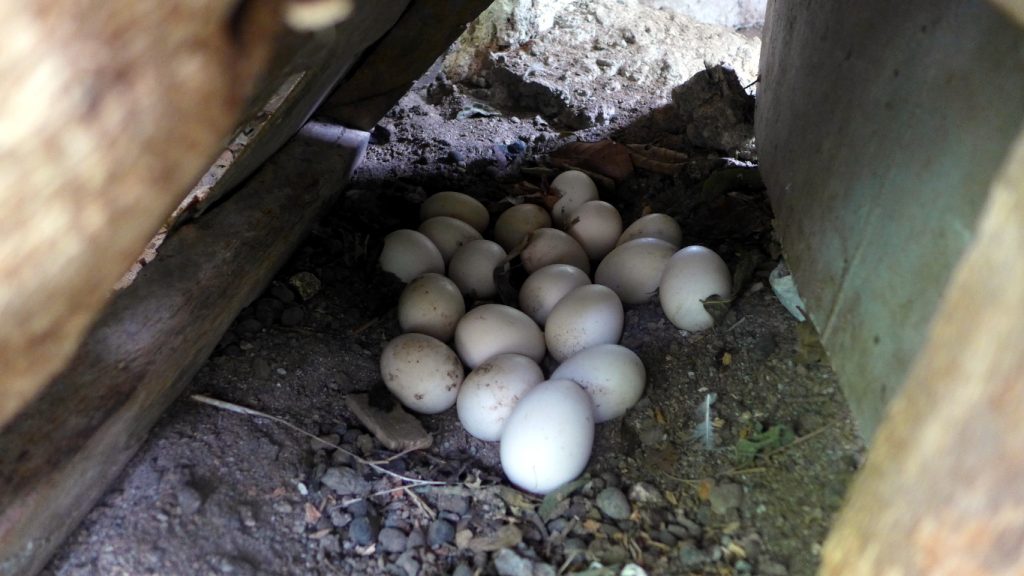
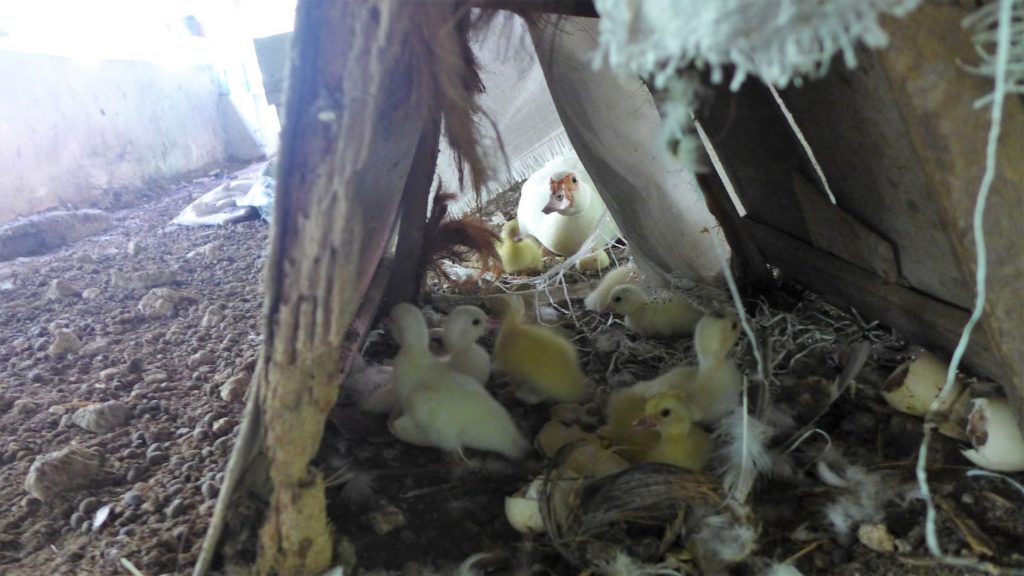
A brooding duck hen is very vulnerable. Give her privacy, keep her nesting area secure, away from aggressive drakes and predators. If snakes and monitor lizards are a constant problem, you may need to secure the entire duck area with netting. If you have an aggressive drake, separate him from the vulnerable hens and ducklings. A hen will sometimes kill her newly hatched ducklings if she feels threatened.
In the photo below, a duck has made a coconut tree stump as her nest. This wasn’t a safe place because it is frequented by monitor lizards that eat duck eggs.

Ducks have different rearing behaviours, some make very good mothers while others don’t. Most ducks make good mothers if kept in a safe environment.
Duck Behaviour and Socialisation
When introducing new ducks to an existing flock, segregate the new ducks for a while. If you introduce a new drake to a flock with a drake, they will fight to establish hierarchy. The advantage of a large backyard space is that ducks can flee from aggression and the likelihood of injury and fatality is minimised. Once hierarchy is established there will be very little if any fighting.
In the video below, if there is ample space, ducklings can escape from aggression.
Ducks are notorious for their aggressive mating behaviour. Drakes can kill duck hens and her ducklings. If you have a flock of ducks, don’t let the hens sit on eggs or rear ducklings all at the same time. There will be no hens for the drake and he will attempt to mate with brooding hens, breaking eggs and killing small ducklings.
In our experience, ducks socialise fine with native chickens in a free range environment. As long as there’s enough space, animals can escape from fights and aggression. Otherwise, they get trapped. Native chickens can be quite aggressive – in fact, they are much more aggressive than ducks. A hen with chicks or a rooster can peck a small duckling and kill it. So if you keep ducks in a small confined space, keep them separate from native chickens.
In the video below, a duck protects her ducklings from piglets foraging in the garden.
Messy Ducks?
Ducks are messy. They poop all the time. And the poop is a huge stream of muck. This isn’t too bad on a surface of rough grass and weeds, but can be dangerously slippery on concrete, compacted soil and walkways. I’ve had a few accidents slipping on duck poop. It can get quite dangerous during the rainy season too.

We discovered that one way to minimize the muck is to acidify the duck’s drinking water. We haven’t tried vinegar but what we’ve found citric acid to be quite effective. 1-2 teaspoons in a liter of water seem sufficient, just don’t put more than 5% in the water. Proper acidification improves gut health and digestion, resulting in more solid poop and healthier ducks. It also reduces irritating odors. Experiment and see what works for your ducks.
We also noticed that acidification results to thickening of blood. If you find this a problem when you slaughter ducks (and chickens), withhold the acidification in water for 2-3 days before slaughter.
Disease
Over the past years of keeping ducks, we have never had disease. We never saw the need to use antibiotics or multivitamins. Our duck fatalities were all due to drake aggression, accidental trampling in a feeding frenzy, ducks going into the pigpen and getting eaten by pigs and overfeeding of very young ducklings.
Strangely, we also noticed that since introducing ducks into our flock of native chickens, we’ve had a marked decrease in disease amongst the native chickens. We can only speculate that the ducks have brought in immunity to pathogens amongst our native chickens. We are yet to find studies that confirm or explain our experience.
Good Luck and Enjoy Your Ducks!
As long as your ducks are not overcrowded and are treated well, they should be fine. Ducks are sturdy, very robust animals. They are one of the easiest animals to keep in a backyard setting.
We hope that this bit of information helps you in your backyard duck-raising journey. Just leave a comment if you have any questions and we’ll do our best to answer them.







